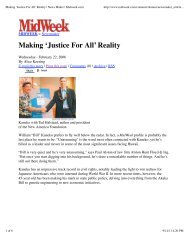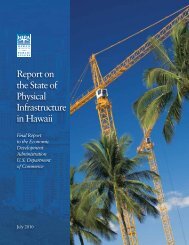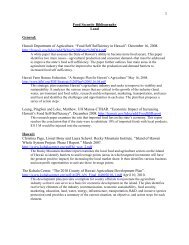Hawai'i Fisheries Initiative - The Hawaii Institute for Public Affairs
Hawai'i Fisheries Initiative - The Hawaii Institute for Public Affairs
Hawai'i Fisheries Initiative - The Hawaii Institute for Public Affairs
Create successful ePaper yourself
Turn your PDF publications into a flip-book with our unique Google optimized e-Paper software.
purposes, VMS can help determine, in<br />
a timely manner, when catch limits within<br />
designated areas have been reached;<br />
VMS can also monitor activity near critical<br />
habitat areas. VMS complements NOAA<br />
observer programs. 243<br />
u Dockside monitoring of landings and sales –<br />
state and federal concerns include insufficient<br />
staffing to provide necessary coverage 244<br />
A small vessel tracking system pilot project<br />
is underway via a partnership between<br />
Wespac and the U.S. Coast Guard, and<br />
contractor Oceantronics Inc. 245 Using VHF<br />
frequencies (radio transmission) similar<br />
to those used in Automatic Identification<br />
System (AIS) allows agencies to track<br />
small vessels (less than 50 feet in length),<br />
providing a cost-effective plan <strong>for</strong> both<br />
en<strong>for</strong>cement and safety monitoring. 246 <strong>The</strong><br />
range currently being tested is 50 miles<br />
from shore, although higher antennas could<br />
extend the range to 100 miles. 247<br />
Seasonal closures – such as a seasonal<br />
closure <strong>for</strong> bottomfish in the MHI – have<br />
been examined by the U.S. Coast Guard,<br />
which recommends an “extremely strong<br />
shoreside en<strong>for</strong>cement component,” to<br />
complement at-sea en<strong>for</strong>cement (For<br />
example, possession of bottomfish during<br />
the closed period would be illegal). 248<br />
Currently, the state does not distinguish<br />
between commercially and recreationally<br />
registered bottomfish boats (both have<br />
to display a BF designation on their<br />
vessels). 249 So, <strong>for</strong> example, if a TAC only<br />
affects the commercial sector, it makes<br />
en<strong>for</strong>cement more difficult as the agent<br />
would need to board and inspect the<br />
catch, then determine whether the fisher is<br />
commercial or recreational, and<br />
if commercial, whether he intends to sell<br />
the catch. 250<br />
Ecological Acoustic Recorders (EARs)<br />
are successfully being used to monitor<br />
coral reef ecosystems in Hawai‘i and<br />
elsewhere, and they’ve also proven<br />
effective at picking up vessel sounds. In<br />
the National Park of American Samoa, an<br />
EAR that had been deployed <strong>for</strong> seven<br />
weeks recorded much more boat traffic<br />
than the scientists expected. Most of the<br />
vessel activity took place in the early<br />
evening and night hours. EARs may prove<br />
to have significant en<strong>for</strong>cement potential as<br />
well as their primary use as environmental<br />
monitoring devices. 251<br />
Bycatch and Endangered Species<br />
Interaction Issues<br />
<strong>The</strong> MSA defines bycatch as fish caught<br />
but not kept <strong>for</strong> personal use or sold, and<br />
this includes fish that are discarded <strong>for</strong><br />
economic or regulatory reasons as well.<br />
Since 1990, protected species bycatch<br />
issues have increasingly impacted fisheries<br />
management. As previously noted, seabird<br />
bycatch primarily affects the pelagic<br />
longline fisheries. Sea turtle bycatch affects<br />
the swordfish longline fishery and the<br />
bottomfish and pelagic handline fisheries<br />
to a much lesser extent. No reports of<br />
seabird or sea turtle incidental catch<br />
have occurred in the lobster, coral reef,<br />
or precious coral fisheries; no reports of<br />
hawksbill, leatherback, loggerhead,<br />
55







